Applications Manned spaceflight Derivatives ZenitFotonVoskhod First launch May 15, 1960 Crew capacity 1 | Operator OKB-1 Regime Low Earth Built 10+ Status Retired | |
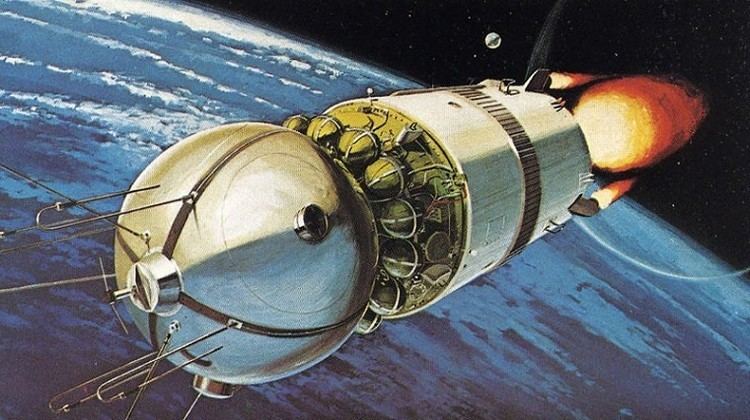 | ||
Manufacturer S. P. Korolev Rocket and Space Corporation Energia Similar Voskhod, Soyuz, Sputnik 1, Mir, Sputnik 2 | ||
The Vostok (Russian: Восток, translated as "East") was a type of spacecraft built by the Soviet Union. The first human spaceflight in history was accomplished on this spacecraft on April 12, 1961, by Soviet cosmonaut Yuri Gagarin.
Contents
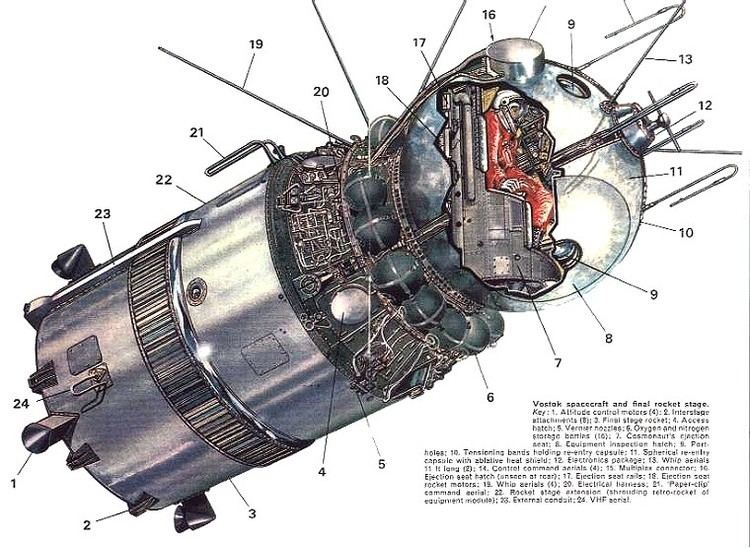
The spacecraft was part of the Vostok programme in which six manned spaceflights were made from 1961–63. Two further manned space flights were made in 1964 and 1965 by Voskhod spacecraft, which were modified Vostok spacecraft. By the late 1960s both were superseded by the Soyuz spacecraft, which are still used as of 2017.
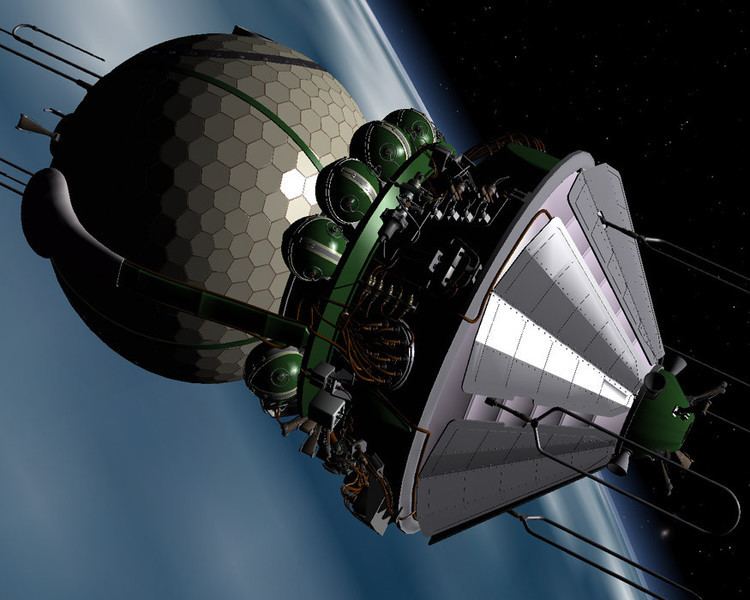
Development
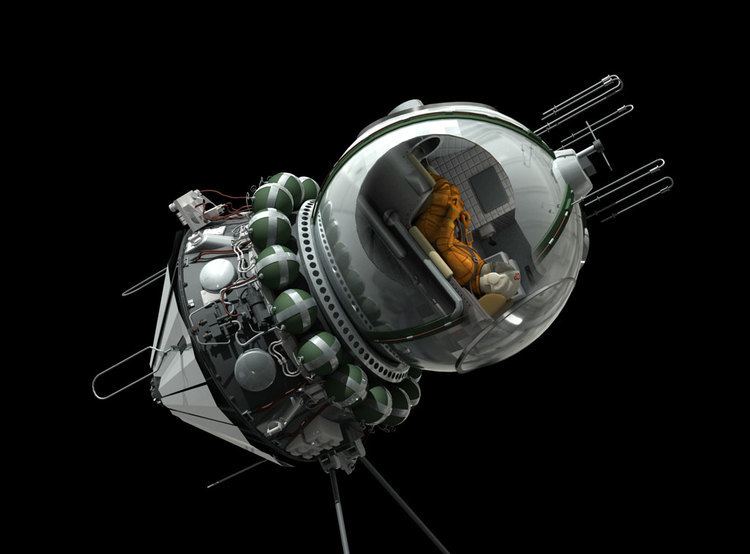
The Vostok spacecraft was originally designed for use both as a camera platform (for the Soviet Union's first spy satellite program, Zenit) and as a manned spacecraft. This dual-use design was crucial in gaining Communist Party support for the program. The basic Vostok design has remained in use for some 40 years, gradually adapted for a range of other unmanned satellites. The descent module design was reused, in heavily modified form, by the Voskhod program.
Design
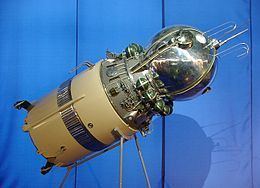
The craft consisted of a spherical descent module (mass 2.46 tonnes, diameter 2.3 meters), which housed the cosmonaut, instruments and escape system, and a conical instrument module (mass 2.27 tonnes, 2.25 m long, 2.43 m wide), which contained propellant and the engine system. On reentry, the cosmonaut would eject from the craft at about 7,000 m (23,000 ft) and descend via parachute, while the capsule would land separately. The reason for this was that the Vostok descent module made an extremely rough landing that could have left a cosmonaut seriously injured.

The ejector seat also served as an escape mechanism in the event of a launch vehicle failure, which at this early phase of the space program was a common occurrence. If an accident occurred in the first 40 seconds after liftoff, the cosmonaut would simply eject from the spacecraft and parachute to Earth. From 40 to 150 seconds into launch, ground controllers could issue a manual shutdown command to the booster. When the launch vehicle fell to a low enough altitude, the cosmonaut would eject. Higher altitude failures after shroud jettison would involve detaching the entire spacecraft from the booster.
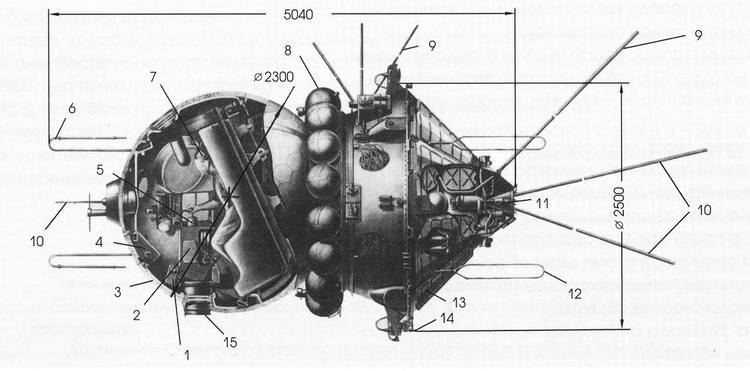
One problem that was never adequately resolved was the event of a launch vehicle malfunction in the first 20 seconds, when the ejector seat would not have enough time to deploy its parachute. LC-1 at the Baikonour Cosmodrome had netting placed around it to catch the descent module should the cosmonaut eject while still on the pad, but it was of doubtful value since he would likely end up landing too close to the exploding booster. An accident in the initial seconds of launch also likely would have not put the cosmonaut in a position where he could make a survivable ejection and in all probability, this situation would have resulted in his death. A 2001 recollection by V.V. Molodsov stated that Chief Designer Sergei Korolev felt "absolutely terrible" about the inadequate provisions for crew escape on the Vostok during the opening seconds of launch.
There were several models of the Vostok leading up to the manned version:
Vostok 1K
Prototype spacecraft.
Vostok 2K
Photo-reconnaissance and signals intelligence spacecraft. Later named Zenit spy satellite.
Vostok 3KA
The Vostok 3KA was the spacecraft used for the first human spaceflights. They were launched from Baikonur Cosmodrome using Vostok 8K72K launch vehicles. The first flight of a Vostok 3KA occurred on March 9, 1961. The first flight with a crew—Vostok 1 carrying Yuri Gagarin—took place on April 12, 1961. The last flight—Vostok 6 carrying the first woman in space, Valentina Tereshkova—took place on June 16, 1963.
A total of 8 Vostok 3KA spacecraft were flown, 6 of them with a human crew.
Specifications for this version are:
Reentry Module: Vostok SA. SA stands for Spuskaemiy apparat - descent system. It was nicknamed "Sharik" (little sphere).
Equipment Module: Vostok PA. PA stands for Priborniy otsek - instrument section.
Reentry
The Vostok capsule had limited thruster capability. As such, the reentry path and orientation could not be controlled after the capsule had separated from the engine system. This meant that the capsule had to be protected from reentry heat on all sides, thus explaining the spherical design (as opposed to Project Mercury's conical design, which allowed for maximum volume while minimizing the heat shield diameter). Some control of the capsule reentry orientation was possible by way of positioning of the heavy equipment to offset the vehicle center of gravity, which also maximized the chance of the cosmonaut surviving g-forces while in a horizontal position. Even then, the cosmonaut experienced 8 to 9g.
If the retrorocket failed, the spacecraft would naturally decay from orbit within ten days, and the cosmonaut was provided with enough food and oxygen to survive until that time.
